The Friends of the Wildflower Garden, Inc.
Plants of the Eloise Butler Wildflower Garden
The oldest public wildflower garden in the United States
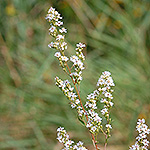
Common Name
White Arrowleaf Aster (Arrow-leaved Aster)
Scientific Name
Symphyotrichum urophyllum (Lindl.) G.L. Nesom
Plant Family
Aster (Asteraceae)
Garden Location
Upland
Prime Season
Late Summer to Autumn
White Arrowleaf Aster is a native perennial aster growing from 1 to 4 feet in height, unbranched below the floral array. The stems are green initially and may have fine white hair, particularly within the array. Stems take on a reddish tone in full sun.
Leaves: Leaves vary considerably depending on position. Middle stem leaves have a narrowly heart shaped to truncate base, with a lanceolate shape blade, somewhat arrow shaped providing the common name; these usually have a winged stalk. Lower basal leaves will usually have heart shaped bases, a long stalk with less of a wing and usually drop off by flowering time. Upper leaves can be stalkless or have a short winged stalk - these are less likely to look arrow shaped. Leaf edges vary from entire to a few small teeth to a number of coarse teeth. The underside of the leaf is of paler color with fine white hair on the mid-rib and some of the larger veins.
The floral array is a open branched panicle, taller than wide, with branches tending upward, usually crowded with racemes of flower heads. Plants growing in full sunlight will have tighter, more narrowly cone-shaped flower racemes whereas in those plants with less sun, the racemes will be more broad.
Flowers: Individual flowers are small, up to 1/2 to 3/4 inch wide, but usually 1/2 or slightly less. Flowers have two types of florets: Ray florets with 8 to 15 rays that can be colored from white to pale blue. These are pistillate and fertile. These surround about 10 to 15+ tubular disc florets that have light yellow corollas when young, but like most aster florets in this genus, turn reddish-purple toward maturity. The yellow lobes of the disc corolla tube do not flare outward at the apex like those of many other asters but, instead, bend inward a bit. Anthers of the five stamens are darker colored and appressed against the style, which with an appendage on top, is exserted from the corolla at flowering time. Phyllaries of the flower head are long and narrow in 4 to 6 series, those of the inner series appressed, the outer lower ones outward spreading. They are light colored with a green tip in the shape of an elongated diamond. Tips can also take on a purplish tint. There is usually several small linear leafy bracts subtended to each flower head which grade into the phyllaries.
Seed is a small dry 4 to 6 nerved brown or purple obovoid shaped cypsela, 1.8 to 2.5mm long, with a whitish pappus for wind distribution. Some species of the Symphyotrichum genus have seeds that may require at least 30 to 60 days of cold stratification for germination and in addition seeds of this genus are small and need light for germination so they should be surface sown.
Habitat: White Arrowleaf Aster grows from a rhizomatous root system with stout branched caudices, in partially sunny spots that are not overly moist - wood edges, disturbed soils, roadsides. The plant readily self-seeds.
Names: The older scientific name for this aster is Aster sagittifolius. All the new world asters, formerly in the genus Aster, have now been reclassified, most into the genus Symphyotrichum. The genus name is from the Greek symphysis, for 'junction', and 'trichos', for hair and, while obscure, it was first applied by Christian Gottfried Daniel Nees von Esenbeck in the 1800s in describing the type aster for the genus. The species urophyllum, means 'leaves with a tail-like tip' - which in this case is a bit dense but probably refers to the small whip-like tip of the larger leaves (see photo below). The old species name referred to the arrow shape leaves which was a bit more straight-forward. The author names for the plant classification are as follows: ‘Lindl.’ is for John Lindley (1799-1865), English botanist who authored or co-authored a number of articles and books on plants, some with his own colored engravings; he was particularly interested in roses and orchids, an active member of the Royal Horticultural Society and a University professor. His work on this species was revised by ‘G. L. Nesom’ who is Guy L. Nesom (b. 1945) American botanist who has published papers on the nomenclature of asters.
Comparisons: The small flowers and conical floral array resemble the Heart-leaved Aster, Symphyotrichum cordifolium, but there the leaves are heart-shaped with coarser teeth and a narrower stalk. Closest in overall style is The White Panicle Aster, Symphyotrichum lanceolatum, which has a bushy panicle of many flowers also, but the flowers can be twice the size, the plant is taller and the leaves are linear to lance-like. See photo comparison below.
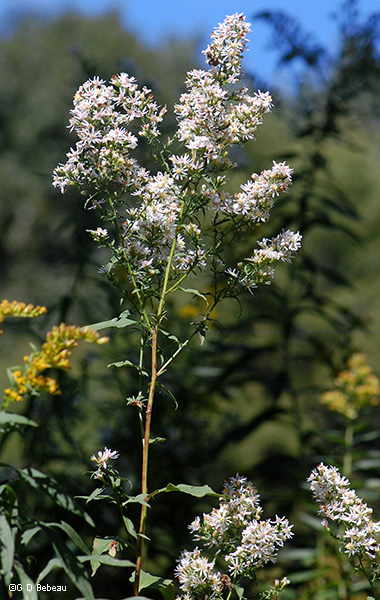
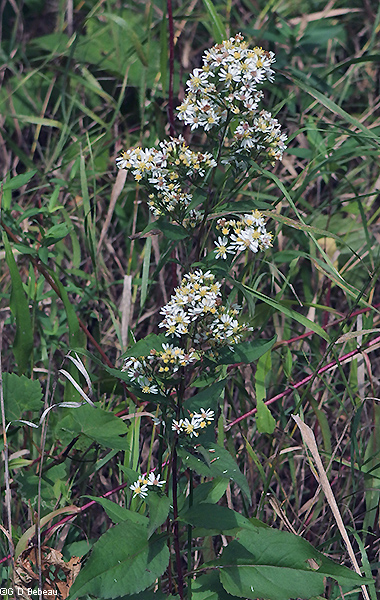
Above: 1st photo - The floral array of an older plant and (2nd photo) a young plant. Note - plants growing if full sunlight usually have tight narrowly cone-shaped flower clusters.
Below: The floral array is an open branched panicle, longer than wide, each flower with a short stalk. Branches of the panicle tend upward. Note the difference in the 1st and 3rd photo as to the tightness of the flower clusters - caused by exposure to more or less sunlight.
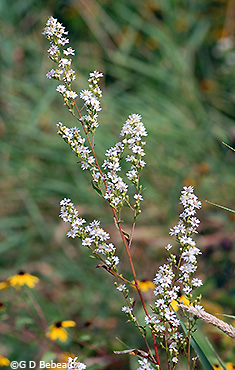
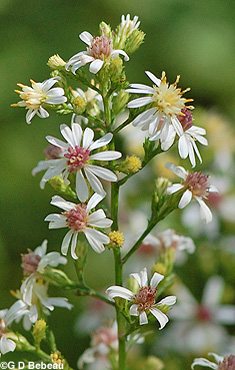
Below: 1st photo - The phyllaries of the flower head have green elongated diamond tips, the outer series spreading. Note the small leafy bracts below the flower head. 2nd photo - The mid-stem leaves have a base and form resembling an arrow. Note the wings on the leaf stalk. 3rd photo - The underside of the leaf is paler with fine white hair on the mid-rib and some of the larger veins.
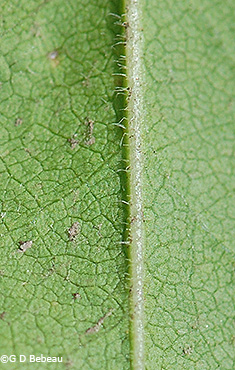
Below: The seeds are a dull brownish purple obovoid shape cypsela with 4 to 6 nerves on the surface and a whitish to rose pappus attached.
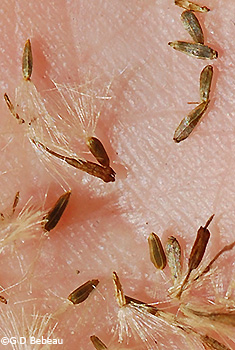
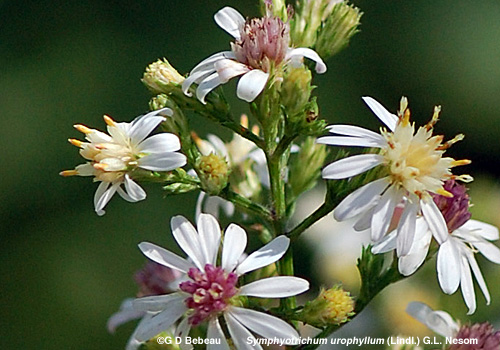
Above 2nd photo and Below 1st photo : The disc florets have 5 lobes to the yellow corolla, each have a toothed apex that bends inward a bit. They turn more reddish at maturity as seen in the last photo on this page. 2nd photo - leaf comparison: Top - one of the larger lower leaves with a narrow heart-shaped base, coarser teeth and the narrower wing on the stalk compared to the leaf shown up above. Middle - mid to upper stem leaf with winged stalk. Bottom - leaf within the floral array with short winged stalk.
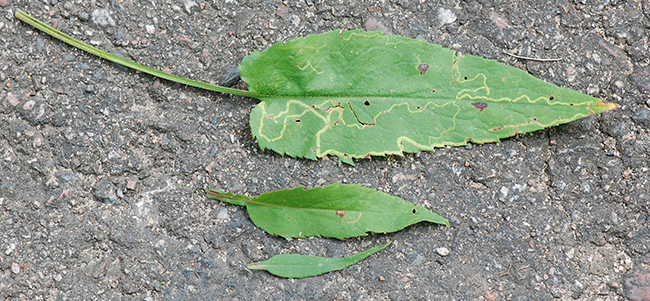
Below: A comparison of the larger stem leaf with that of Short's Aster, (S. shortii) which could be confusing prior to flowering time.
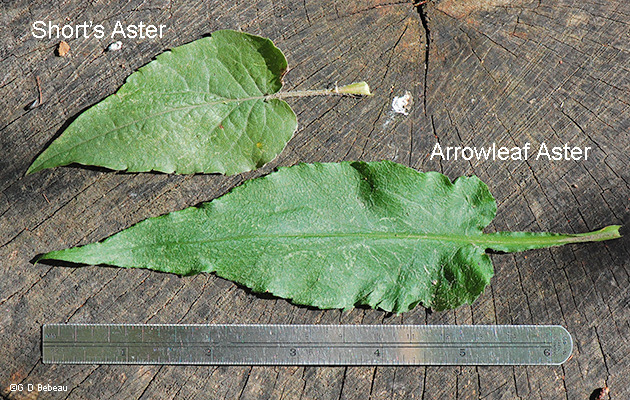
Below: Both the White Panicle Aster and the White Arrowleaf Aster have erect panicles filled with white flowers. The key difference is the size of the flower and the shape of the phyllaries. Here you see the extremes - a very large White Panicle and a very small White Arrowleaf.
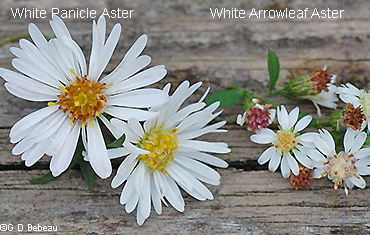
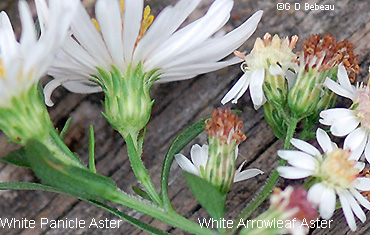
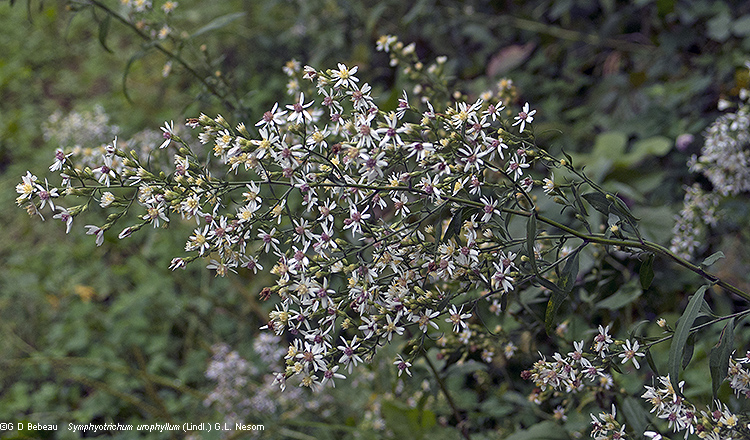
Notes: It is not clear if White Arrowleaf Aster was indigenous to the Garden or if Eloise Butler added it, however, she noted it in bloom on Aug. 11, 1914 and in the 33rd Report of the Board of Park Commissioners (for the year 1915), Eloise Butler wrote a section on the Wild Flower Garden and listed all the asters in the Garden. She wrote: "Aster sagittifolius is of refined beauty. It has a wand-like habit and is crowed with blossoms of medium size, generally white or pale blue, with purplish disc." This plant was included on the list of 19 species in the article. Asters are difficult to study. Eloise planted it many times beginning in 1916, then in '21, '24, '26, '27, '29, and 1932. White Arrowleaf Aster was listed on Martha Crone's 1951 inventory of plants in the Garden at that time but she never made note of planting it, but because it self-seeds easily it probably has been in the Garden continuously.
There are twenty-four species just of Symphyotrichum listed by the DNR and the U of M as being found in Minnesota, some with several subspecies. In Hennepin County where the Garden is located, White Arrowleaf Aster is common. In Minnesota this species is found in counties of the eastern and southeastern part of the state. In the U.S. its native range is the eastern half excluding Louisiana. In Canada it is known in Ontario.
Return to -- Site Plan/Archive Index --or-- List of Common Plant Names -- or -- List of Scientific Names -- or --Home Page - - - Back to top.
References: Plant characteristics are generally from sources 1A, 32, W2, W3, W7 & W8 plus others as specifically applied. Distribution principally from W1, W2 and 28C. Planting history generally from 1, 4 & 4a. Other sources by specific reference. See Reference List for details.
 Identification booklet for most of the flowering forbs and small flowering shrubs of the Eloise Butler Wildflower Garden. Details Here.
Identification booklet for most of the flowering forbs and small flowering shrubs of the Eloise Butler Wildflower Garden. Details Here.
©2015
Friends of the Wildflower Garden, Inc. Text and photos are by G. D. Bebeau unless otherwise credited. "www.friendsofeloisebutler.org"
040820